


Understanding Lever Chain Blocks Mechanisms and Applications
Lever chain blocks, often referred to simply as chain hoists or chain blocks, are essential tools in various industries for lifting and lowering heavy loads with precision and ease. The fundamental mechanics behind these devices make them indispensable in construction, manufacturing, and warehousing applications.
What is a Lever Chain Block?
A lever chain block consists of a chain, a lever, and a wheel mechanism that work together to lift or lower heavy objects. The primary components include the hand chain, load chain, lifting hook, and the lever arm. When the user pulls down on the hand chain, the lever arm rotates, allowing the load chain to move upwards and lift the attached load.
How Does it Work?
The operation of a lever chain block hinges on basic mechanical principles. The lever arm amplifies the force applied by the user, making it possible to lift significantly heavier weights than one could lift by hand. When pulling the hand chain, the user applies force to the lever, which rotates around a pivot point. This rotation transfers the mechanical advantage, allowing the load chain to move and, consequently, lift the load.
In general, transfer gears within the mechanism translate the user's pull into a greater lifting power. The ratio of the lever arm length to the load's distance from the pivot contributes to this mechanical advantage; the longer the lever arm, the less force is needed to lift a given weight.
Advantages of Lever Chain Blocks
1. Portability Lever chain blocks are usually compact and lightweight, making them easy to transport and operate in various locations. 2. Versatility They can lift loads vertically or horizontally and can be used in multiple settings, including construction sites, workshops, and storage facilities.

4. Cost-Effectiveness Compared to electric hoists or cranes, lever chain blocks are generally more affordable and require less maintenance.
Applications of Lever Chain Blocks
Lever chain blocks are widely used across numerous sectors. In construction, they facilitate lifting and placing heavy materials such as steel beams, concrete blocks, and roofing materials. In manufacturing environments, they support assembly lines by helping move heavy components into position seamlessly. Additionally, they are often used in warehouses for loading and unloading goods.
In automotive repair shops, lever chain blocks assist in lifting engines and other heavy parts, while in maritime industries, they are crucial for rigging and hoisting operations on ships and docks.
Safety Considerations
Despite their ease of use and efficiency, safety must always be a priority when operating lever chain blocks. Users should ensure all safety hooks are properly closed and check the load's weight against the block’s capacity. Regular inspections are essential to identify wear and tear, and training users on proper handling techniques is crucial to prevent accidents.
Conclusion
Lever chain blocks epitomize the marriage of simplicity and effectiveness in industrial lifting. With their user-friendly design and mechanical principles, they continue to be a reliable choice for various lifting tasks across multiple industries. Understanding their mechanics, advantages, and applications can help professionals harness their full potential, making work safer and more efficient. As industries evolve, the innovation in design and safety features of lever chain blocks will undoubtedly keep pace, ensuring they remain a staple for heavy lifting for years to come.



